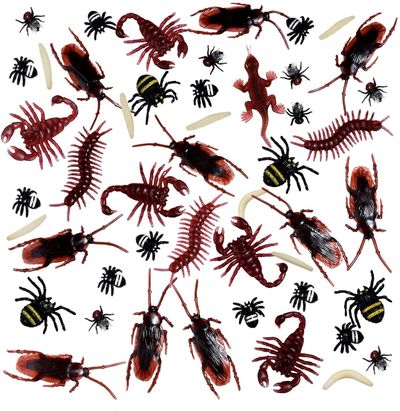Home of the Insectocutioner!!!
Providing thorough, professional expertise for all your residential and commercial pest control needs!
Providing thorough, professional expertise for all your residential and commercial pest control needs!
Home of the Insectocutioner!!!
Providing thorough, professional expertise for all your residential and commercial pest control needs!
Providing thorough, professional expertise for all your residential and commercial pest control needs!

INTEGRATED PEST MANAGEMENT APPROACH:


The annual cost for control and repair to termite damaged structures in the United States is more than $5 billion. Annual reinspections of treated residential structures usually vary from $100-$175.00 depending on how frequently during the year the location is serviced by the pest control professional. More detail about the pest in question can be found at http://entnemdept.ufl.edu/creatures/urban/termites/native_subterraneans.htm
Proper evaluation of future requirements should involve a discussion about any past treatment measures, how and what was applied, the amount of time since last treatment and a through inspection of the structure to identify any conducive environmental conditions that may increase the chances for termites to attack your dwelling. According to industry research, liquid barrier termite treatment generally lasts between five and eight years, depending on the product used, and how well the barrier was applied. Research has since shown that barrier products that are non-repellent and lethal to termites tend to be most reliable. Current examples include Termidor® /Taurus® (fipronil), Premise® (imidacloprid), and Altriset® (chlorantraniliprole). While such treatments are usually effective, large volumes of termiticide are applied around the perimeter of the building, accompanied by drilling/injection through adjacent porches and patios.
Termite bait systems present a new way to control termite colonies that is more effective and less invasive. After installation, some or all of the stations are provisioned with bait. Termites cannot see or smell the baits in the soil; they more or less wander into them during their persistent foraging activities.
To increase the odds of discovery, stations are installed at fixed intervals —typically 10 to 15 feet apart around the entire perimeter of the home. Additional stations are often placed in known or suspected areas of termite activity, such as around woodpiles, stumps, moist areas, and near previous termite damage. With patience and a little luck, the termites eventually find and feed on one or more of the installations. More detailed information on termite baiting can be found at https://entomology.ca.uky.edu/ef639
The exact price depends on whether the home has a slab foundation or a crawl space as well as the number of monitoring stations, and/or amount of trenching/drilling required. Your contract terms play a part in pricing as well. Treatments can be designated to cover retreatment only, or repairs and retreatment for a specified limit of liability, usually $100,000 maximum damages.
A thorough termite inspection takes between 1-3 hours. We look forward to scheduling an appointment with you!
Carpenter ants, termites and other wood-destroying insects do not cause wood decay. These insects are, however, attracted to wood that has been softened by decay.
Worldwide, rats and mice spread over 35 diseases. These diseases can be spread to humans directly, through handling of rodents, through contact with rodent feces, urine, or saliva, or through rodent bites. Diseases carried by rodents can also be spread to humans indirectly, through ticks, mites or fleas that have fed on an infected rodent.
The primary strategy for preventing human exposure to rodent diseases is effective rodent control in and around the home. This is achieved by eliminating any food sources, sealing even the smallest entries into homes, and successfully trapping rodents in and around the home.
You have options for ridding your property of a rat or mouse infestation.
Always place traps and baits in places where children and pets cannot reach them.
Urban Pest Control can provide an initial inspection and treatment for rodents to your homes interior and exterior. Depending on the severity of pest populations for your location, additional trips for treatments/monitoring may be required. A comprehensive action plan involving physical exclusion and proper sanitation must be followed by the customer to meet control goals.
Inspection and treatment usually takes one hour. We look forward to scheduling an appointment with you!
Cockroaches have various common names including water bugs, croton bugs and palmetto bugs. There are at least 69 different cockroach species found in the United States. Outside, cockroaches are decomposers, feeding on dead or dying plants and animals. However, they are considered pests when they interact with people, invading lawns and gardens or entering homes and other structures. More importantly, they can affect human health by spreading diseases, such as Salmonella, and ruin materials such as books, clothes and food.
Cockroaches hide in dark, sheltered places during the day and come out to feed at night. Inside, they may be found around the kitchen sink or drain board, in cracks around or underneath cupboards and cabinets or inside them (especially in the upper corners), behind drawers, around pipes or conduits (where they pass along the wall or go through it), behind window or door frames, behind loose baseboards or molding strips, on the underside of tables and chairs, in the bathroom, and in radio and TV cabinets.
The German cockroach is usually found in the kitchen and bathroom, although it may be found all over the house. The other cockroaches prefer damp, warm places and usually develop in garages, sewers, attics, storerooms and similar locations, and then enter the home from outside breeding sites.
The German cockroach has three life stages typical of insects with incomplete metamorphosis: the egg, nymph, and adult. The entire life cycle is completed in about 100 days. However, factors such as temperature, nutritional status, and strain differences may influence the time required to complete a life cycle. German cockroaches breed continuously with many overlapping generations present at any one time. Under ideal conditions, population growth has been shown to be exponential.
Non toxic and low toxic alternatives for German cockroach control are available. Sticky traps can be used to monitor or reduce population size. Improving sanitation by eliminating food and water sources and clutter can have a significant impact on reducing the chances of infestation population size. Finally, exclusion practices such as sealing cracks and crevices will reduce harborage space and also negatively impact population size.
Depending on the severity of pest populations for your location, additional treatments/monitoring may be required.
Inspection and treatment usually takes less than one hour. We look forward to scheduling an appointment with you!

Spiders are predators that feed on insects and other arthropods. Most often they are quite beneficial to our environment, and are harmless. In the United States, about 6,000 species have been identified and only two groups occasionally are harmful to humans. Recluse and widow spiders have been associated with significant pathology and very rare reports of death.
Urban Pest Control can provide a one-time treatment for spiders as well as a wide spectrum of other household pests to your homes interior and exterior. Depending on the severity of pest populations for your location, additional treatments/monitoring may be required.

Mosquitoes can make life miserable. Many recreational and work activities have been ruined by the constant annoyance and irritation caused by their bites. Also, some species can transmit serious diseases. Successful long term mosquito control requires a knowledge of where and how they develop. All mosquitoes pass through four life stages: egg, larva, pupa, and adult.
The number of days from egg to adult varies with species and temperature. Under ideal conditions, some mosquitoes can complete their cycle of development from egg to adult in less than a week.
Mosquitoes can be kept out of the home by keeping windows, doors, and porches tightly sealed and insect screens in good repair. The occasional mosquito that may enter can be eliminated with a fly swatter. Aerosol foggers and other indoor insecticides labeled for mosquitoes, gnats, and other flying insects seldom provide relief at dosages applied by householders.
However, there are effective steps that individuals can take to minimize mosquito breeding on their property:

There are more than 700 ant species found in the U.S., although only about 25 species commonly infest homes. Ants are social insects that typically live in underground colonies, made up of workers and a queen. Ants will eat practically any kind of food, but are especially attracted to sweets. Ant identification is relatively simple due to their three distinct body regions: head, thorax and abdomen, as well as antennae. Despite similar construction, ants vary in overall appearance. Small or large ants and brown or black ants are common nicknames for different species.
If you do find signs of an ant infestation in your home, contact Urban Pest Control promptly. We will be able to inspect your home, perform proper ant species identification, and recommend a course of ant control and extermination.


At Urban Pest Control, we apply professional grade materials such as DSV disinfectant/sanitizer from Nisus Corp. The service protocols are industry leading and include sanitation of all hard surfaces and touch points. DSV has been proven to kill harmful germs, bacteria, fungi, and virus including Corona Virus. This product is proven safe to use in any residential setting.
Stop the spread of germs and protect yourself with our professional sanitizing services. We select professional grade products that are highly effective against disease-causing bacteria. In addition to killing germs and bacteria, our sanitizing solution eliminates mildew and disinfects viruses, including Hantavirus, Hepatitis B, Hepatitis C, HIV-1 (AIDS Virus), Influenza A/Brazil Virus, and Influenza A H1N1. The EPA recently concluded our products are effective against SARS-CoV-2, the virus that causes COVID-19.
We strive to be in constant communication with our customers until the job is done. For estimates or questions on our services, please contact us at your convenience. We look forward to meeting you soon!
Monday - Thursday: 8AM–8PM
Friday: 8AM-5PM
Sunday: 8AM–5PM
CLOSED ON SATURDAY


Payments also available via SQUARE, ZELLE and CASH APP.


